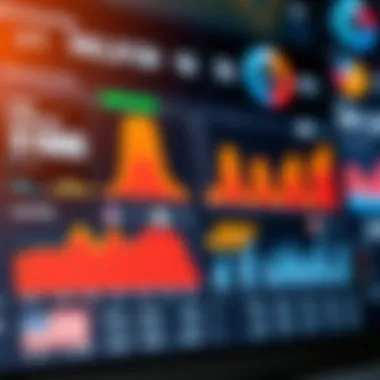Understanding Costs of Facebook Sponsored Ads


Intro
When talking about online advertising, Facebook always stands tall as a giant in the arena. Its sponsored ads have revolutionized how businesses connect with audiences around the globe. Understanding the costs associated with these ads is akin to unraveling a well-guarded secret; it requires knowledge, strategy, and a pinch of finesse. As we delve deeper into this article, the key point will not only be the expenses but also the value derived from these marketing moves.
In the next sections, we will dissect the costs of Facebook sponsored ads and present valuable insights, proving that being well-informed can make a significant difference in ad performance and budget management. Armed with this understanding, marketing professionals and business owners can navigate Facebook's advertising landscape more effectively, optimizing both their investments and their results.
Effective Business Sales Techniques
Overview of Sales Strategies
To effectively harness the power of Facebook's sponsored ads, one must grasp various sales strategies that enhance online visibility and engagement. A successful selling approach can involve both direct outreach and creative content, encouraging potential customers to take action.
For instance, retargeting plays a vital role in keeping your brand top-of-mind for those who have previously engaged, be it through a website visit or an abandoned cart. By strategically showing ads to these users on Facebook, businesses can draw them back in. There's a fine art to timing and creative design, which often means experimenting until you find the sweet spot that resonates with your audience.
- The effectiveness of a multi-channel approach often hinges on how these sales strategies align within the broader marketing ecosystem.
- It's critical to ensure that your messaging is consistent across platforms, whether it’s social media, email, or even your website.
The Sales Funnel Process
Understanding the sales funnel is essential when planning your Facebook advertising content. At its core, the sales funnel is a visual representation of the customer journey, outlining how potential customers move from awareness to action.
- Top of the funnel (Awareness): Here, you want to catch attention. Think catchy visuals paired with compelling headlines that stop the scroll.
- Middle of the funnel (Consideration): Plans should be laid out to ensure the audience contemplates your solutions. This is where educational content, like videos or blogs, can shine.
- Bottom of the funnel (Decision): Now, it’s time to make your case. Incentives like discounts or limited-time offers can often tip the scales in your favor, nudging them toward a conversion.
By strategically aligning your ad campaigns with these funnel stages, you can better manage advertising costs while driving relevant traffic and increasing conversion rates. As expenses vary based on the precision of targeting and the ad format used, understanding your funnel can help you allocate your budget wisely.
In the world of Facebook ads, knowing your audience is key—tailored ads result in higher engagement and better returns.
As we continue, we will further explore how to optimize costs, focusing on appropriate budgeting techniques and fundamental metrics crucial for refining spending on Facebook sponsored ads.
Prologue to Facebook Sponsored Ads
When thinking about digital marketing, the conversation is incomplete without Facebook. It’s crucial for marketers and entrepreneurs to grasp what Facebook Sponsored Ads are and how they operate in the wider context of advertising.
Facebook has evolved over the years from being just a casual social networking site to a powerhouse of targeted advertising. Understanding Facebook Sponsored Ads means delving into how businesses can leverage this platform’s vast audience. It’s not merely about creating ads but instead about understanding the subtleties that can lead to greater engagement and conversion rates. The aspect of targeting features immediately opens up diverse marketing opportunities, making it a pillar for those involved in sales and outreach.
The Evolution of Advertising on Facebook
To appreciate Facebook Sponsored Ads, we must acknowledge their origin. Initially, advertising on Facebook was rudimentary, allowing businesses to promote posts to their current followers. As the user base exploded and data analytics matured, Facebook pivoted towards a more robust advertising model. The introduction of Ad Manager in 2012 transformed the landscape, enabling marketers to track performance metrics and adjust strategies accordingly.
Facebook honed its algorithms to offer unparalleled targeting options based on user behavior, preferences, and even geographical locations. This means businesses are no longer just flinging spaghetti at the wall, hoping something sticks; they can now aim directly at a bullseye by tailoring campaigns that speak to the audience they want to reach. The continuous development in ad formats—from image and video ads to dynamic ads—reinforces Facebook’s adaptability to market demands and user preferences.
The Importance of Facebook in Digital Marketing
In today’s hyper-competitive market, Facebook is not just an option; it’s a necessity. The platform boasts over 2.8 billion monthly active users, presenting a fertile ground for brand visibility and lead generation. This number signifies not just potential reach but also the diverse demographics that businesses can target.
Utilizing Facebook Sponsored Ads allows businesses to tap into intricate data points about their desired audience, enhancing precision in targeting. The platform offers remarkable insights into who is responding to ads, how they’re interacting, and what can be improved in future campaigns. This dual-benefit approach—awareness combined with actionable data—creates a strong argument for utilizing Facebook in any comprehensive marketing strategy.
Moreover, the cost-effectiveness of advertising on Facebook relative to traditional mediums like television or print is noteworthy. Businesses can reach their audiences more directly at various price points.
"It’s not just about advertising; it’s about conversing with consumers in a space they feel comfortable."
In essence, understanding Facebook Sponsored Ads is vital for anyone looking to expand their brand’s reach and increase conversions. The evolution of advertising on the platform and its crucial role in digital marketing underscores the necessity of mastering this tool for today’s marketers.
Cost Structure of Facebook Sponsored Ads
Understanding the cost structure of Facebook sponsored ads is crucial for anyone looking to make informed investments in digital marketing. The way these costs are structured can significantly impact how effectively a business allocates its advertising budget. Knowing the various types of costs and how they interact with strategic goals helps advertisers maximize their potential reach while keeping expenditures in check. Different pricing models suit different objectives; grasping this concept enables businesses to tailor their advertising approach to match their specific needs, ultimately fostering a more effective marketing campaign.
Types of Ad Costs
Cost per Click (CPC)
Cost per Click, or CPC, is a pricing model where advertisers pay each time a user clicks on their advertisement. This model stands out for being performance-oriented, as it ensures that funds are only spent when there is genuine interest in the ad. A significant advantage of CPC lies in its straightforward nature; advertisers can easily measure the direct response to their campaigns, making it easier to determine effectiveness.
One unique feature of CPC is that it encourages the creation of compelling and relevant ads since a click signifies user engagement. However, it can become costly if the ad itself does not convert clicks into desired actions, like a purchase or sign-up. Marketers must be cognizant of this risk when focusing solely on clicks without considering overall conversion rates.


Cost per Impression (CPM)
Cost per Impression (CPM) refers to a model where advertisers pay based on how many times their ad is displayed, regardless of whether it is clicked. This approach is beneficial for brand awareness campaigns where the goal is to maximize visibility rather than immediate action. CPM is often seen as a way to reach a broad audience swiftly, making it a popular choice for companies looking to enhance brand recognition.
The unique feature of CPM is its suitability for large-scale ad campaigns, allowing more extensive reach without tying costs to individual user engagement. However, a con of this model is that it does not guarantee interaction; if the ad isn't engaging enough, impressions may not translate to clicks, leaving advertisers with limited actionable results.
Cost per Action (CPA)
Cost per Action, or CPA, is a model where payment occurs only when a specific action is completed by the user, such as making a purchase or signing up for a newsletter. CPA aligns closely with conversion goals, making it a cost-effective option for many advertisers who prioritze tangible results. The precise nature of CPA allows businesses to focus their spending directly on conversions, ensuring that their budget directly contributes to their bottom line.
A notable aspect of CPA is its performance-weighted strategy, where the cost is directly tied to measurable outcomes. This offers a safety net since businesses only pay when a target is reached. On the flip side, CPA can be challenging to optimize. If the desired action is obscure or if there is low traffic, determining the right target CPA can prove difficult, complicating campaign adjustments.
Setting Up Your Budget
Daily Budget vs. Lifetime Budget
When setting up a budget for Facebook ads, two primary options are typically available: daily budget and lifetime budget. A daily budget caps spending on a day-to-day basis, providing greater control over daily expenditures and maintaining marketing pacing. It’s useful for advertisers who want a steady spend and engagement over time.
On the other hand, a lifetime budget allows for a total ad spend over the life of the campaign, letting Facebook manage daily allocations. This approach offers some breathing room for ad performance fluctuations. Each method has advantages; the daily budget can be beneficial if the advertiser wants more immediate oversight, while lifetime budgets allow for broader strategies based on ad performance over the entire duration.
Ad Spend Limits
Setting ad spend limits is another essential aspect of managing Facebook advertising costs. Ad spend limits define the maximum amount one can incur within a specified time frame. It’s a safeguard against unexpected overspending, ensuring that campaigns remain within budgetary constraints.
The key characteristic of ad spend limits is their role in financial management, allowing businesses to set boundaries that align with overall marketing budgets. While useful, imposing strict limits may inadvertently cap potential reach if ads perform well beyond initial expectations. Thus, a careful balance is essential to harnessing the benefits while also reining in costs.
Factors Influencing Ad Costs
In the realm of Facebook sponsored ads, understanding the costs isn't just about knowing prices; it's about grasping the key factors that shape these costs. Each campaign is as unique as the business behind it. Whether you’re a small business owner or a seasoned marketer, recognizing the variables that impact these expenses can be instrumental in maximizing your return on investment. By diving into elements such as target audience, ad quality, and relevance, you can refine strategies that not only save you money but also boost your effectiveness in reaching potential customers.
Target Audience and Reach
Demographic Considerations
When considering demographic considerations, think of it as the backbone of your ad strategy. Getting to know your audience—age, gender, interests—helps in shaping your campaign. For instance, targeting a younger crowd through vibrant visuals and trendy language can be more effective than using formal tones suited for professionals. This personalized approach creates a connection.
The hallmark of demographic targeting is its precision. It’s like a well-tuned instrument which, when strummed correctly, resonates beautifully with your intended audience. However, a lack of understanding here can lead to unwanted costs. If your product appeals more to college students, advertising it broadly rather than honing in on that demographic can waste resources and result in lesser engagement.
Advantages of demographic targeting include:
- Higher relevance leading to better engagement.
- Reduced waste of ad spend when targeted appropriately.
But, it also comes with its disadvantages. If you narrow your focus too much, you may miss out on potential customers that fall outside your defined demographic.
Geographic Targeting
Now let’s talk about geographic targeting. This is another crucial area that can have a huge impact on your ad costs. It’s not just about where your audience lives but understanding the local nuances that can shape your message. For example, promoting warm-weather attire in Florida is a no-brainer, while winter coats would flop physically and financially there.
One key characteristic of geographic targeting is its ability to adjust to cultural preferences. Ads that resonate within certain regions tend to yield better results, thus lowering your cost per engagement. Conversely, failing to consider geographical differences can lead to poorly received content.
There are notable pros to using geographic targeting:
- Improved relevance for local cultures and preferences.
- Increased chances of conversion when ads speak the local language, literally and figuratively.
However, the flipside can also be tricky; being too focused may limit your reach and potential market opportunities in nearby regions.
Ad Quality and Relevance
Importance of Engagement
In a crowded digital space, engagement is where it’s at. The importance of engagement cannot be overstated; it directly influences how often your ad will be shown and to whom. Engaging ads draw people in. Think of a specific ad that stopped you in your track—what was it about? Maybe it was the humor or the memorable visuals. Engaging content tends to generate comments, likes, and shares, which can significantly drive down costs.
Key advantages of fostering engagement include:
- Increased visibility due to Facebook's algorithm favoring engaging ads.
- Larger audience reach through shares among followers.


However, it’s a double-edged sword. If engagement plummets, so does your ad’s effectiveness, leading to wasted spend and poor performance.
Relevance Score Explained
Finally, what about the relevance score? This metric is an essential learning curve for anyone diving into Facebook advertising. It tells you how your audience is responding to your ads. A high relevance score means lower costs because you are seen as more valuable to those clicking. If your ad isn’t relevant, it indicates misunderstanding either in target audience or ad content.
The unique feature of the relevance score is that it combines various engagement metrics. This score is vital in steering ad tweaks and changes.
The main advantages of a high relevance score include:
- Decreased costs per click or impression.
- An enhanced comprehension of what your audience finds appealing, allowing for better targeting in the future.
Yet, the danger lies in ignoring this score or misunderstanding it. A low score could lead you down a costly path until you recalibrate your strategy.
Understanding these factors helps frame your approach towards Facebook ads. Each aspect plays its role in the broader picture, contributing to the expenses incurred and ultimately impacting your success on the platform.
Strategies for Cost Management
Understanding cost management strategies is essential for getting the most bang for your buck when using Facebook ads. Every ad placement decision can profoundly affect the overall budget and return on investment. By implementing effective cost management, marketers can fine-tune their campaigns, prioritize success metrics, and improve efficiency.
Optimizing Ad Campaigns
Testing Different Ad Formats
Testing different ad formats is critical in determining which style resonates best with your audience. Facebook offers a variety of formats, from carousel ads that showcase multiple images to video ads that engage viewers dynamically. Each format has its unique characteristics and can attract different segments of your target audience.
The real beauty in testing these formats lies in their flexibility. For instance, a carousel ad can increase engagement by allowing users to swipe through multiple images. This interactive element tends to hold attention longer, which may lead to a higher click-through rate. However, one must also consider that not every audience will respond positively to all formats.
By continuously A/B testing the formats, advertisers can pinpoint what works. The disadvantage, however, is that it requires time and effort to analyze results to adapt strategies accordingly. But in the grand scheme, it's a beneficial approach to maximizing ad engagement.
Using Audience Insights
Diving into audience insights is another pivotal strategy. Facebook provides a wealth of data about user interactions. This information can help you refine your target audience and tailor ads that resonate better with potential customers.
The beauty of using audience insights lies in its ability to inform about user behavior. For instance, you might discover that a specific demographic engages more with your ads on weekends. Adjusting your ad schedule to align with this insight could lead to increased conversions. The downside is that the overwhelming amount of data can be confusing for some users, potentially leading to analysis paralysis.
Nonetheless, leveraging audience insights efficiently can help you avoid misallocated budgets and boost overall effectiveness, making it a wise investment of resources.
Adjusting Bids and Budgets
Manual vs. Automatic Bidding
When managing bids, marketers find themselves at a crossroads between manual and automatic bidding strategies. Manual bidding allows for precise control over how much should be spent per click or impression. This can be a strong choice for seasoned advertisers who know their market well.
On the other hand, automatic bidding is often favored by those who prefer convenience. Facebook’s algorithm will set bids based on the maximum budget and your set goals. While this can be a time-saver, it may lead to higher costs if not monitored closely. Both approaches have their advantages; the key is to assess the specific needs of your campaign and decide accordingly. If you're feeling lucky, automatic bidding can yield good results; however, staying hands-on with manual bidding can offer further control over expenditures.
Adjusting for Performance
Lastly, adjusting bids based on performance is necessary to ensure that every dollar spent is yielding results. Marketers must keep an eye on how ads are performing over time. If an ad isn't meeting objectives, it might be wise to cut back on spending for that specific campaign while reallocating that budget to better-performing ads.
Performance adjustment involves looking at metrics like click-through rates and conversion rates. It's a characteristic of incremental improvement—small changes can lead to significant gains. The downside, however, is that this approach requires constant monitoring and an analytical mindset, which can be taxing. But when done right, it can lead to more effective spending and improved overall performance of your Facebook ads.
Remember, efficient cost management in Facebook advertising isn't just about cutting expenses; it's about smartly reallocating your budget to maximize returns.
Evaluating ROI from Facebook Ads
Evaluating the return on investment (ROI) from Facebook ads can be as crucial as the ad creation itself. Often, marketers dive into crafting eye-catching ads without a clear understanding of how to measure success. This section unpacks the essence of ROI in the context of Facebook advertising while bringing to light the specific elements that matter.
When you understand ROI, you can gauge whether your advertising dollars are well spent or if you're merely throwing good money after bad. With the right metrics in place, businesses can avoid the pitfall of vanity metrics—those numbers that may look good but don’t translate into actual business value.
Defining Success Metrics
Tracking Conversions


At its core, tracking conversions refers to counting the number of desired actions taken by users after interacting with an ad, like making a purchase or signing up for a newsletter. This metric is indispensable as it directly correlates to the effectiveness of your ad. If you get a thousand clicks but no sales, it raises a red flag.
One of the key characteristics of tracking conversions is its simplicity. It helps you paint a clearer picture of how your campaigns are performing. This data-driven approach allows for adjustments to be made in real time. However, this method requires setup and ongoing maintenance, which can be a downside for some.
Tracking conversions can mean the difference between an ad campaign that thrives and one that flounders.
Understanding Customer Lifetime Value
Customer lifetime value (CLV) offers insights into how much profit a business can expect from a customer throughout their relationship. This metric isn’t just catchy jargon; it’s pivotal for strategic planning and budget allocation. Knowing your CLV helps you spend accordingly on acquiring new customers.
The emphasis on CLV revolves around its predictive nature. By understanding how much value a customer can bring, marketers can evaluate how much they should invest in advertising. However, calculating CLV could prove complex. There are many factors like retention rate and average purchase frequency at play, making it less straightforward than tracking conversions.
Tools for Measuring Ad Success
Using Facebook Analytics
Facebook Analytics has become an integral tool for tracking ad performance. It provides valuable data regarding audience behavior, allowing marketers to understand user engagement more profoundly. One of its standout features is the ability to measure customer journeys across various touchpoints.
Utilization of Facebook Analytics can lead to better decision-making and resource allocation. However, it’s worth noting that not all businesses have the capability to interpret this rich data. Insights gained might be overwhelming for those unfamiliar with analytics, making training a necessary step.
Integrating Third-Party Tools
Integrating third-party tools can significantly enhance the assessment of ad performance. These platforms often offer advanced analytics capabilities that complement Facebook's own tools. By utilizing platforms like Google Analytics or HubSpot, businesses can gather additional metrics that provide a more comprehensive picture of ad effectiveness.
A key characteristic of third-party integration is the enhanced data granularity. This additional level of detail can reveal insights that native tools might miss. However, businesses must be cautious about tracking adaptations that come with using multiple systems. Issues of data consistency may arise, necessitating thorough vetting and regular audits to ensure accuracy.
By understanding these metrics and leveraging the right tools, entrepreneurs and marketing professionals can make informed decisions that significantly improve the ROI from their Facebook sponsored ads.
Future Trends in Facebook Advertising Costs
In the fast-paced realm of social media advertising, staying ahead of trends isn't just a good idea; it's vital. With the digital landscape morphing nearly every day, grasping the future trends in Facebook advertising is essential for businesses wanting to remain competitive. As marketing professionals, entrepreneurs, and startup founders analyze how these shifts might affect their advertising costs, they can better strategize and allocate their budgets.
Evolving Advertising Standards
As the saying goes, "you gotta change with the times." This rings true for Facebook ads as advertisers need to constantly adapt to new guidelines, policies, and best practices for effective advertising. The evolution of advertising standards means that what worked yesterday might not cut it today. For instance, Facebook's recent focus on privacy and user experience has led to stricter regulations regarding the handling of user data and transparency in ad targeting.
These changes can also cause fluctuations in ad costs as businesses need to ensure compliance while maintaining effectiveness. To counter some of these expenses, companies might want to invest in ad creatives that not only capture attention but also align closely with Facebook's evolving advertising rules. Optimizing for these changes can lead to better engagement rates, ultimately reducing costs in the long run.
- Ad Formats: As video content takes precedence, consider reallocating budgets towards high-performing video ads.
- User Engagement: Ads that encourage interaction or feedback may find favor in the evolving standards, potentially lowering costs.
As the advertising landscape shifts, businesses that adapt will not only survive but thrive.
The Impact of Algorithm Changes
Algorithms are the lifeblood of social media platforms, and Facebook is no exception. The algorithms dictate what users see in their feeds, which in turn affects the visibility of advertisements. Changes to these algorithms can significantly impact both the reach and cost of Facebook ads. Understanding the nuances of algorithm changes can make a world of difference in campaigns.
For instance, if Facebook shifts its focus toward more organic content, businesses relying solely on paid ads might find themselves at a disadvantage. Being adaptive to these algorithmic adjustments can involve changes in ad content, targeting, and testing new strategies. Consider this: if an algorithm favors local small businesses, then local targeting might become more valuable for minimizing costs and increasing conversions.
- Target Shift: Keep an eye on new target audience insights that may arise along with algorithm updates.
- Content Quality: High-quality and relevant content is more likely to achieve favorable placements, thus reducing overall ad spend.
The End
Wrapping up our examination of Facebook sponsored ads, it’s clear that understanding costs is not just a matter of numbers. It’s about grasping the interplay between various factors that influence the pricing and performance of your campaigns. Each advertiser needs to navigate this landscape with caution and strategy. Key insights from this discussion highlight how crucial it is to tailor your approach based on your target audience and constantly evaluate your ad performance to ensure you're getting the most out of your investment.
Recap of Key Insights
- Cost Structure: Dive deeper into the specifics of ad costs, including Cost per Click (CPC), Cost per Impression (CPM), and Cost per Action (CPA). Each type of cost plays a significant role in your overall ad strategy and budgeting decisions.
- Influence of Factors: The characteristics of your target audience, such as demographics and geographical areas, can sway costs significantly. The relevance and quality of your ad also comes into play, affecting how Facebook charges advertisers.
- Effective Budget Management: Considering daily versus lifetime budgets and setting ad spend limits are practical steps. Continually tweaking and optimizing your ad bids based on performance data ensures your resources don’t go down the drain.
- Evaluating ROI: Establishing clear metrics for success is paramount. Track conversions accurately and understand the overall customer lifetime value to gauge the true impact and effectiveness of your ads.
Incorporating these insights can lead to more informed decision-making and ultimately better returns on your advertising investments.
Final Thoughts on Effective Facebook Advertising
In the fast-paced world of digital marketing, staying ahead of the curve is not optional for entrepreneurs and sales professionals. Effective Facebook advertising requires an ongoing commitment to learning and adapting.
As algorithms evolve and audience preferences shift, remember that maintaining flexibility in your strategies is key. Leveraging tools like Facebook Analytics helps to gain deeper insights into your ad performance, enabling timely adjustments.
Furthermore, nurturing a high relevance score and engaging your audience are non-negotiable elements for success. Without these, you might find your ads lost among a sea of content, failing to resonate with potential customers. In essence, your strategy should be holistic—addressing every facet from audience targeting to continuous optimization for long-term success.
For additional resources on Facebook advertising, check out the official guide on Facebook Ads or delve into more detailed analyses at Wikipedia on Online Advertising for background knowledge.
Engage with current trends and discussions on forums like Reddit Ads for up-to-date strategies and community insights.



